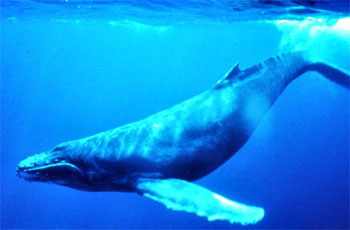Whales share human brain cells
Whales share human brain cells
mongabay.com
November 27, 2006
Whales share brain cells with humans according to a new study published online November 27, 2006 in The Anatomical Record, the official journal of the American Association of Anatomists. The research suggests that “certain cetaceans and hominids may have evolved side by side.”
Examining brains from various cetaceans, the group of marine mammals that includes whales and dolphins, Patrick R. Hof and Estel Van der Gucht of the Department of Neuroscience at Mount Sinai School of Medicine in New York, NY found substantial variability between the cell structure of the cortex in humpback whales compared to toothed whales like dolphins. The authors say that “these differences may indicate differences in brain function and behavior in aquatic species that are not yet understood,” according to a news release from John Wiley & Sons, Inc. The release continues,
-
One feature that stood out in the humpback whale brain was the modular organization of certain cells into “islands” in the cerebral cortex that is also seen in the fin whale and other types of mammals. The authors speculate that this structural feature may have evolved in order to promote fast and efficient communication between neurons. The other notable feature was the presence of spindle cells in the humpback cortex in areas comparable to hominids and in other areas of the whale brain as well. Although the function of spindle neurons is not well understood, they are thought to be involved in cognitive processes and are affected by Alzheimer’s disease and other debilitating brain disorders such as autism and schizophrenia. Spindle neurons were also found in the same location in toothed whales with the largest brains, which suggests that they may be related to brain size.
 Humpback Whale, Megaptera novaeangliae. Courtesy of NOAA. |
The authors note that spindle neurons probably first appeared in the common ancestor of hominids about 15 million years ago, since they are observed in great apes and humans, but not in lesser apes and other primates; in cetaceans they evolved earlier, possibly as early as 30 million years ago. It is possible that they were present in the ancestors of all cetaceans, but were retained only in those with the largest brains during their evolution. It may also be that they evolved several times independently in the two cetacean suborders; part of this process may have taken place at the same time as they appeared in the ancestor of great apes, which would be a rare case of parallel evolution.
“In spite of the relative scarcity of information on many cetacean species, it is important to note in this context that sperm whales, killer whales, and certainly humpback whales, exhibit complex social patterns that included intricate communication skills, coalition-formation, cooperation, cultural transmission and tool usage,” the authors state. “It is thus likely that some of these abilities are related to comparable histologic complexity in brain organization in cetaceans and in hominids.”
“Cetacean and primate brains may be considered as evolutionary alternatives in neurobiological complexity and as such, it would be compelling to investigate how many convergent cognitive and behavioral features result from largely dissimilar neocortical organization between the two orders,” they conclude.
“The Structure of the Cerebral Cortex of the Humpback Whale, Megaptera novaeangliae (Cetacea, Mysticeti, Balaenopteridae),” Patrick R. Hof, Estel Van der Gucht, The Anatomical Record, Published Online: November 27, 2006. (DOI: 10.1002/ar.a.20407).
This article is based on a news release from John Wiley & Sons, Inc.